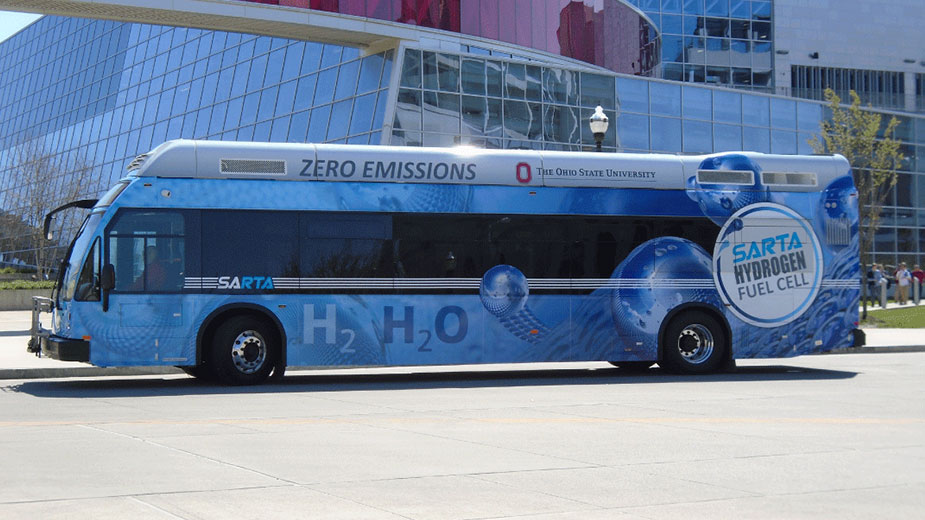Consortium Launches Campaign For $2B Clean Hydrogen Hub in Ohio
YOUNGSTOWN, Ohio — A coalition of energy producers, industrial consumers, research institutions, elected officials and community leaders is spearheading a campaign to convince the U.S. Department of Energy to locate a Clean Hydrogen Hub in the state of Ohio.
The group, The Ohio Clean Hydrogen Energy Alliance, says such a hub could spur billions of dollars in public and private investment and create thousands of jobs.
“The idea is to connect users, storage, R&D and producers of hydrogen in an approximate geographic area,” says Kirt Conrad, CEO of the Stark Area Regional Transit Authority, or SARTA, and a founding member of the Alliance. “We want to create an ecosystem where hydrogen can succeed and be a model for the rest of the world.”
A total of $8 billion in funding for the creation of these hubs was included in the $1.2 trillion Infrastructure Investment and Jobs Act. The Alliance is seeking $2 billion in funding to develop a hub in Ohio.
SARTA, along with the The Midwest Hydrogen Center of Excellence, Dominion Energy, and Cleveland State University formed the Alliance in mid-January.
Since then, more than 70 public and private sector entities have joined the group including the Battelle Memorial Institute, Babcock and Wilcox, Encino Energy, Columbia Gas, Kent State University, and Travel Centers of America. More information about the Alliance including a complete membership list is available at OH2hub.org.
Conrad explained that a clean hydrogen hub is a region in which various users of hydrogen across industrial, transport and energy markets work together to innovate, collaborate, and develop the workforce and skills needed to support a robust hydrogen industry.
In the Mahoning Valley, for example, McDonald Steel Corp. wants to use hydrogen to power its operations in order to reduce its carbon footprint, Conrad says.
“The CHH funding creates the opportunity for Ohio and Ohioans to reap the economic and environmental benefits that will flow from the federal government’s commitment to, and massive investment in, the development of clean hydrogen technology,” Conrad says.
SARTA operates the third-largest fleet of hydrogen fuel cell-powered buses, he says.
More recent developments, such as Intel’s decision to invest $20 billion to build two semiconductor production facilities near Columbus demonstrates the state’s ability to manage large projects. And last week, hydrogen fuel-cell manufacturer Hyperion announced it would relocate its headquarters from Southern California and invest $297 million into a new operation in Columbus.
Conrad says that SARTA has worked closely with researchers at Cleveland State University over the years on the potential of developing a hydrogen market in Ohio. “The need for hydrogen in Ohio will quadruple over the next 20 years,” he says, citing an upcoming study.
According to the Alliance, an Ohio-based hydrogen hub could generate billions of dollars in public and private sector investment, fuel hydrogen and zero emission research and development, create and preserve thousands of skilled jobs, and lead to a significant reduction in emissions. It would also maximize use of Ohio’s natural gas resources and enable leading transportation providers, energy producers, steelmakers, refineries, paper mills, and manufacturers to meet carbon reduction goals.
Energy companies that produce natural gas from the Utica-Point Pleasant shale play in Ohio stand to benefit from such a network, Conrad says, since methane can be converted into hydrogen.
Jackie Stewart, spokeswoman for Encino Energy, said the company is pleased to support the Alliance’s initiative.
“As the fourth-largest private producer of natural gas and oil in the United States with all our operations in Ohio, we believe that natural gas is the most reliable feedstock to the development and deployment of clean hydrogen,” Stewart says. “Natural gas will continue to play a critical role in powering the United States and the world, and we are excited to pursue this opportunity as we stand with the Ohio Clean Hydrogen Hub Alliance as a proud partner and advocate toward this effort.”
Conrad says engine manufacturers such as Indiana-based Cummins, which has a strong presence in Ohio, have developed entire divisions around developing alternative fuel cells and batteries, Conrad says.
Renewable energy companies such as Babcock & Wilcox, headquartered in Akron, are already heavily invested in the development of hydrogen fuel technology.
“Clean hydrogen fuel and technologies to produce and use it will play a critical role as the world works to achieve net-zero greenhouse gas emissions by 2050,” Chairman and Chief Executive Officer Kenneth Young said in a statement. “B&W is proud to be a member of the Ohio Clean Hydrogen Hub Alliance, and we believe our BrightLoopTM hydrogen generation and BrightGenTM hydrogen combustion technologies are ideally suited to support the Alliance’s mission of creating a hydrogen hub in Ohio.”
The Alliance says that Ohio’s vibrant manufacturing sector, natural resources, skilled workforce, research institutions, and existing end users of hydrogen makes the state an ideal location for a hub.
Conrad said the Alliance plans an aggressive effort to build broad support for an Ohio hub because competition for the billions of dollars on the table will be fierce.
“West Virginia, Pennsylvania, North Dakota, New Mexico, Texas, New York, and a number of other states have announced they will submit proposals for a hub,” he noted. “Our goal is to ensure that Ohio is in the best possible position to secure a CHH when the selection process begins.”
“Clean hydrogen is now an integral component of America’s long-term energy strategy,” he said. “We can either be a leader in the hydrogen-fueled zero emission economy of the 21st Century or we can be left standing at the side of the road as the future drives by. The members of the Alliance firmly believe Ohio should lead.”
Image: Stark Area Regional Transit Authority
Copyright 2024 The Business Journal, Youngstown, Ohio.



